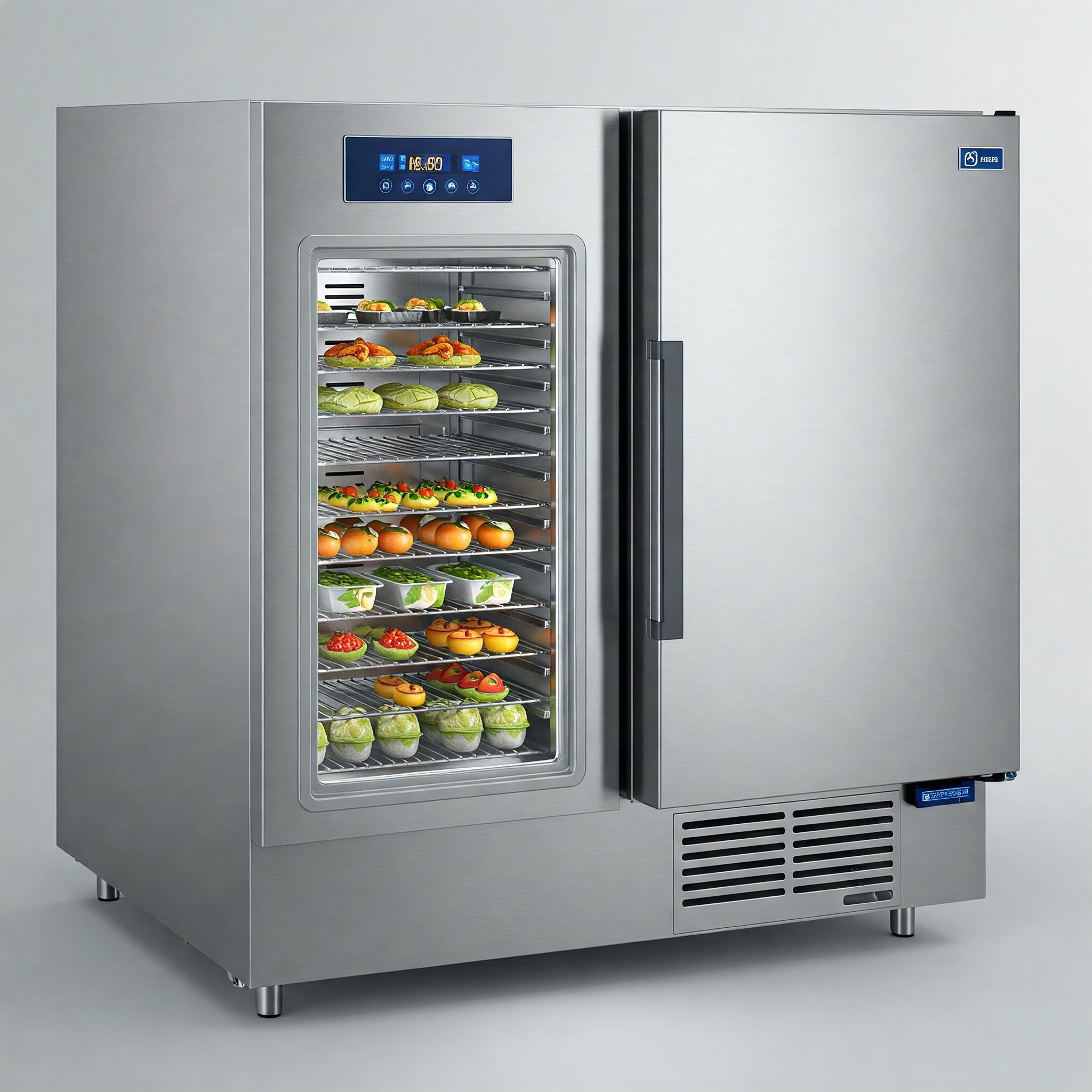Blast Chiller Freezers: Rapid Cooling and Freezing for Maximum Food Preservation
Blast chiller freezers, also known as shock freezers, are high-performance refrigeration units designed to rapidly lower food temperatures, preserving freshness, texture, and safety. They are essential in commercial kitchens, catering services, bakeries, and food processing industries, ensuring compliance with food safety regulations while improving efficiency.
What Are Blast Chiller Freezers?
Blast chiller freezers combine rapid chilling and freezing functions, quickly reducing food temperatures to prevent bacterial growth and preserve quality. Unlike standard freezers, which take hours to freeze food, blast freezers can bring food from +70°C to -18°C (158°F to 0°F) in less than 4 hours, significantly extending shelf life while maintaining texture and nutritional value.
Key Features of Blast Chiller Freezers
- Dual-Function Cooling and Freezing
- Offers both rapid chilling (+70°C to +3°C in 90 minutes) and shock freezing (+70°C to -18°C in under 4 hours).
- Preserves Food Quality
- Prevents large ice crystal formation, keeping food textures intact.
- HACCP Compliance
- Meets international food safety standards by preventing bacterial growth.
- Digital Temperature Control
- Programmable settings for precise chilling and freezing.
- Rapid Airflow System
- High-velocity cold air ensures even and efficient cooling.
- Multiple Tray Capacities
- Available in various sizes, from small countertop units to large industrial models.
- Energy Efficiency
- Designed with eco-friendly refrigerants and insulated panels to reduce power consumption.
- Automatic Defrosting
- Prevents ice buildup, ensuring consistent performance.
- Stainless Steel Construction
- Durable and easy to clean, maintaining hygiene standards.
Types of Blast Chiller Freezers
1. Countertop Blast Freezers
- Compact, space-saving units for small kitchens or bakeries.
- Ideal for chilling small batches of food quickly.
2. Reach-In Blast Freezers
- Mid-sized units designed for restaurants and catering services.
- Offers multiple shelves for high-volume chilling and freezing.
3. Roll-In / Trolley Blast Freezers
- Large-capacity models used in large-scale food production.
- Designed to accommodate entire trays or trolleys of food.
4. Bakery and Pastry Blast Freezers
- Specifically designed for cooling delicate dough, pastries, and baked goods.
5. Industrial Blast Freezers
- High-capacity units for mass food production and frozen food storage.
Applications of Blast Chiller Freezers
- Restaurants and Catering Services
- Prepares meals in advance and safely stores them for future service.
- Bakeries and Pastry Shops
- Rapidly cools cakes, pastries, and dough without altering texture.
- Seafood and Meat Processing
- Freezes fish, meat, and poultry to preserve freshness.
- Hotels and Large Kitchens
- Helps store large quantities of prepared meals without spoilage.
- Frozen Food Manufacturers
- Used in mass production of frozen ready-to-eat meals.
- Hospitals and Institutional Kitchens
- Ensures hygienic meal preparation and extended food storage.
Benefits of Blast Chiller Freezers
- Prevents Bacterial Growth
- Rapid freezing prevents food from staying in the danger zone (5°C – 60°C / 41°F – 140°F), reducing contamination risk.
- Maintains Food Texture and Flavor
- Prevents large ice crystal formation, keeping food moist and fresh.
- Reduces Food Waste
- Extends shelf life, allowing kitchens to store food longer without spoilage.
- Enhances Kitchen Efficiency
- Allows batch cooking and pre-preparation for high-demand service periods.
- Supports HACCP Compliance
- Ensures food is cooled and stored according to food safety guidelines.
- Versatile Freezing Options
- Can be used for meats, seafood, vegetables, dairy, and baked goods.
Choosing the Right Blast Chiller Freezer
- Capacity and Size
- Consider kitchen space and the volume of food to be chilled or frozen.
- Cooling and Freezing Speed
- Look for units with high-speed freezing cycles for efficiency.
- Energy Efficiency
- Opt for models with eco-friendly refrigerants and energy-saving insulation.
- Temperature Range
- Ensure the unit can reach at least -18°C (-0.4°F) or lower for freezing.
- Digital Controls and Automation
- Programmable settings make operation easier and more precise.
- Maintenance Features
- Choose models with automatic defrost and easy-to-clean interiors.
- Multi-Tray Capacity
- Look for models with flexible shelving for different food types.
Maintenance Tips for Blast Chiller Freezers
Daily Maintenance
- Clean Interior and Shelves: Wipe down surfaces to prevent residue buildup.
- Check Temperature Readings: Ensure unit is maintaining the correct settings.
Weekly Maintenance
- Inspect Door Seals: Look for air leaks that could affect performance.
- Clear Air Vents: Remove dust to maintain efficient airflow.
Monthly Maintenance
- Defrost If Needed: Prevent ice buildup that could hinder operation.
- Check Fans and Compressors: Ensure they are functioning properly.
Annual Maintenance
- Professional Servicing: Schedule an inspection for refrigeration components.
- Replace Worn Parts: Upgrade gaskets, filters, and other components as needed.
Troubleshooting Common Issues
- Blast Freezer Not Reaching the Desired Temperature
- Cause: Overloaded unit or blocked air vents.
- Solution: Reduce food load and ensure vents are clear.
- Excessive Ice Formation
- Cause: High humidity or poor door sealing.
- Solution: Defrost regularly and check door gaskets.
- Slow Cooling or Freezing
- Cause: Dirty condenser coils or insufficient refrigerant.
- Solution: Clean coils and check refrigerant levels.
- Unusual Noises
- Cause: Loose components or compressor issues.
- Solution: Tighten screws and inspect compressor function.
- Power Consumption Too High
- Cause: Poor insulation or inefficient cooling system.
- Solution: Check insulation, replace faulty parts, and clean coils.


